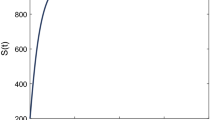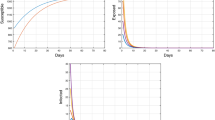Abstract
A disease transmission model of SEIRS type with distributed delays in latent and temporary immune periods is discussed. With general/particular probability distributions in both of these periods, we address the threshold property of the basic reproduction number \(R_0\) and the dynamical properties of the disease-free/endemic equilibrium points present in the model. More specifically, we 1. show the dependence of \(R_0\) on the probability distribution in the latent period and the independence of \(R_0\) from the distribution of the temporary immunity, 2. prove that the disease free equilibrium is always globally asymptotically stable when \(R_0<1\), and 3. according to the choice of probability functions in the latent and temporary immune periods, establish that the disease always persists when \(R_0>1\) and an endemic equilibrium exists with different stability properties. In particular, the endemic steady state is at least locally asymptotically stable if the probability distribution in the temporary immunity is a decreasing exponential function when the duration of the latency stage is fixed or exponentially decreasing. It may become oscillatory under certain conditions when there exists a constant delay in the temporary immunity period. Numerical simulations are given to verify the theoretical predictions.








Similar content being viewed by others
References
Anderson RM, May RM (1991) Infectious diseases of humans: dynamics and control. Oxford Univ Press, Oxford
Bhattacharya S, Adler F (2012) A time since recovery model with varying rates of loss of immunity. Bull Math Biol 74:2810–2819
Bairagil N, Chattopadhyay J (2008) Impacts of incubation delay on the dynamics of an eco-epidemiological system : a theoretical study. Bull Math Biol 70:2017–2038
Bélair J, Campbell SA (1994) Stability and bifurcations of equilibria in a multiple-delayed differential equation. SIAM J Appl Math 54(5):1402–1424
Beretta E, Kuang Y (2002) Geometric stability switch criteria in delay differential systems with delay dependent parameters. SIAM J Math Anal 33(5):1144–1165
Beretta E, Takeuchi Y (1995) Global stability of an SIR epidemic model with time delays. J Math Biol 33:250–260
Blyuss K, Kyrychko Y (2010) Stability and bifurcations in an epidemic model with varying immunity period. Bull Math Biol 72:490–505
Boëlle PY, Bernillon P, Desencio JC (2009) A preliminary estimation of the reproduction ratio for new influenza A(H1N1) from the outbreak in Mexico. Euro Surveill 14(19):19205
Busenberg S, Cooke KL (1980) The effect of integral conditions in certain equations modeling epidemics and population growth. J Math Biol 10:13–32
Cooke KL, van den Driessche P (1996) Analysis of an SEIRS epidemic model with two delays. J Math Biol 35:240–260
Cooke KL, Yorke JA (1973) Some equations modeling growth processes and gonorrhea epidemics. Math Biosci 16:75–101
Diekmann O, Montijn R (1982) Prelude to Hopf bifurcation in an epidemic model: analysis of a characteristic equation associated with a nonlinear Volterra integral equation. J Math Biol 14:117–127
van den Driessche P, Wang L, Zou X (2007) Modeling diseases with latency and relapse. Math Biosci Eng 4(2):205–219
Genik L, van den Driessche P (1999) An epidemic model with recruitment-death demographics and discrete delays. Field Inst Comm 21:237–249
Greenberg JM, Hoppensteadt F (1975) Asymptotic behavior of solutions to a population equation. SIAM J Appl Math 28:662–674
Gojovic MZ, Sander B, Fisman D (2009) Modeling mitigation strategies for pandemic (H1N1) 2009. CMAJ 181(10):673–680
Hale JK (1988) Asymptotic behavior of dissipative systems. Math. Surveys Monogr., 25. AMS, Providence
Hethcote HW (1976) Qualitative analysis of communicable disease models. Math Biosci 28:335–356
Hethcote HW, van den Driessche P (1991) Some epidemiological models with nonlinear incidence. J Math Biol 29:271–287
Hethcote HW, van den Driessche P (2000) Two SIS epidemiologic models with delays. J Math Biol 40:3–26
Hethcote HW, Lewis MA, van den Driessche P (1989) An epidemiological model with a delay and a nonlinear incidence rate. J Math Biol 27:49–64
Hethcote HW, Stech HW, van den Driessche P (1981) Nonlinear oscillation in epidemic models. SIAM J Appl Math 40(1):1–9
Li MY, Muldowney JS, van den Driessche P (1999) Global stability of SEIRS models in epidemiology. Can Appl Math Quart 7(4):409–425
Liu W, Hethcote HW, Levin SA (1987) Dynamical behavior of epidemiological models with nonlinear incidence rates. J Math Biol 25:359–380
Lou Y, Zhao X (2011) A reaction-diffusion malaria model with incubation period in the vector population. J Math Biol 62:543–568
Miller RK (1971) Nonlinear Volterra integral equations. Benjamin, Menlo Park
Mischaikow K, Smith HL, Thieme HR (1995) Asymptotically autonomous semiflows: chain recurrence and Liapunov functions. Trans Am Math Soc 347:1669–1685
Smith HL (1995) Monotone dynamical systems. An introduction to the theory of competitive and cooperative systems. Mathematical Surveys and Monographs, 41, American Mathmatical Society, Providence
Smith HL, Zhao X-Q (2001) Robust persistence for semidynamical systems. Nonlinear Anal 47:6169–6179
Taylor ML, Carr TW (2009) An SIR epidemic model with partial temporary immunity modeled with delay. J Math Biol 59:841–880
Thieme HR (2003) Mathematics in population biology. Princeton Univ Press, Princeton
Wang W, Zhao X (2006) An epidemic model with population dispersal and infection period. SIAM J Appl Math 66(4):1454–1472
Yan P, Feng Z (2010) Variability order of the latent and the infectious periods in a deterministic SEIR epidemic model and evaluation of control effectiveness. Math Biosci 224:43–52
Yang Y, Xiao D (2010) Influence of latent period and nonlinear incidence rate on the dynamics of SIRS epidemiological models. Discrete Contin Dynam Syst Ser B 131:195–211
Yuan Y, Bélair J (2011) Stability and hopf bifurcation analysis for functional differential equation with distributed delay. SIAM J Appl Dyn Syst 10:551–581
Zhao X-Q (2003) Dynamical systems in population biology. CMS books in mathematics, 16. Springer-Verlag, NY
Acknowledgments
Thanks to Dr. X-Q. Zhao for valuable discussions and comments. We are grateful to the anonymous referees for helpful suggestions which led to an improvement of our original manuscript.
Author information
Authors and Affiliations
Corresponding author
Additional information
Supported in part by the Natural Sciences and Engineering Research Council (NSERC) of Canada.
Rights and permissions
About this article
Cite this article
Yuan, Y., Bélair, J. Threshold dynamics in an SEIRS model with latency and temporary immunity. J. Math. Biol. 69, 875–904 (2014). https://doi.org/10.1007/s00285-013-0720-4
Received:
Revised:
Published:
Issue Date:
DOI: https://doi.org/10.1007/s00285-013-0720-4




